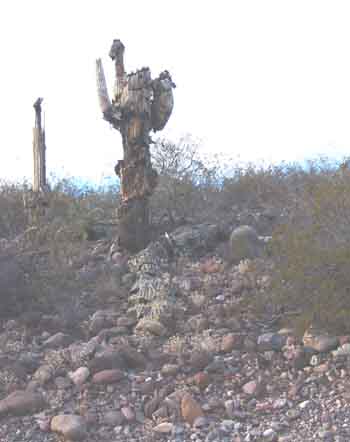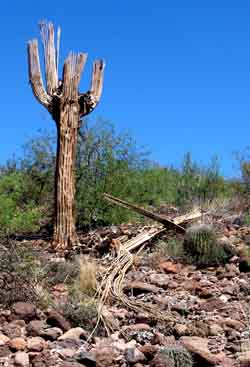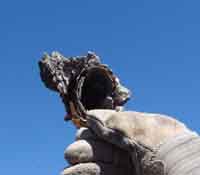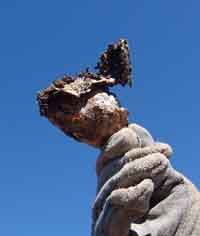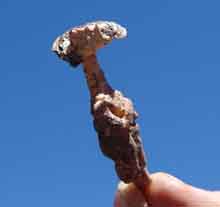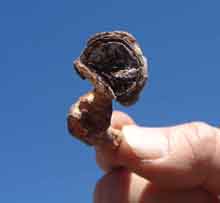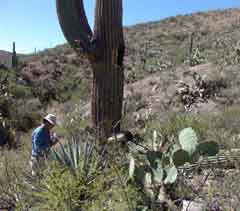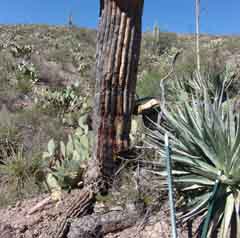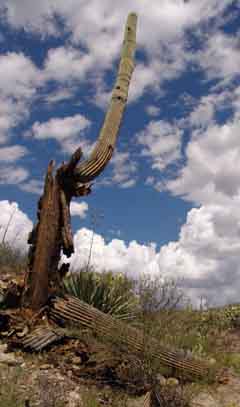Saguaro Ailments, Death and Decay
Main sources: Orum, Tom & Nancy Ferguson, n.d., pers. comm.; Mark Dimmit, Cactaceae (Arizona-Sonora Desert Museum webpage).
Once collapse has occurred, decay tends to be rapid (especially, as is usually the case, if the death occurs during summer storms), with a whole mini-ecosystem of creatures feeding on the fallen remains. By the next winter season, the hardy rib-skeletons remain while the skin and inner pulps have become dusty crusts or eroded away: (Click on left-hand image for enlargement)
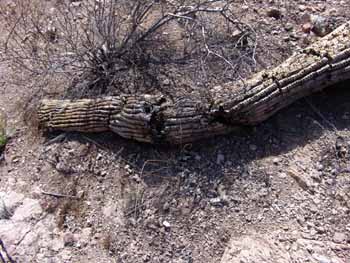 ..
..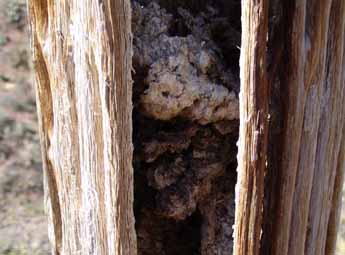
On August 19, 2004, we observed that two of the big saguaros on the hillside just below the Hot Springs Canyon Airport had recently been blasted by lightning. One, below left, directly hit (and its tops and branches blown off), was bleeding its waters out in a sticky but fluid mass. Below right, the second Saguaro (a few yards away) was also blasted at its base, presumably by the explosion of the first, both of them now effectively dead. Click on each image to enlarge it.
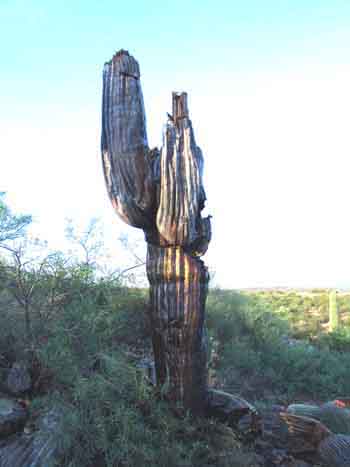 .....
.....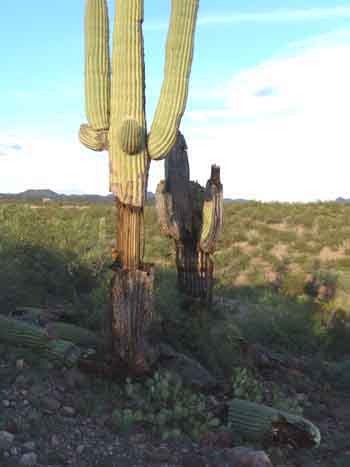
If you look closely at the left-hand image above, you'll see that the trunk is glistening -- it was actually running liquids, very very slowly. The smell was almost overpowering -- not exactly repulsive but certainly very strong and unique (unforgettable). The waters were thick all around the basal area, and they look like they're flowing, but -- as you can see in the image below, it's really myriad maggots feeding on the gooey mix, many thousands of them churning things up and making a collective sound like running water. (Click on the image to enlarge it.)
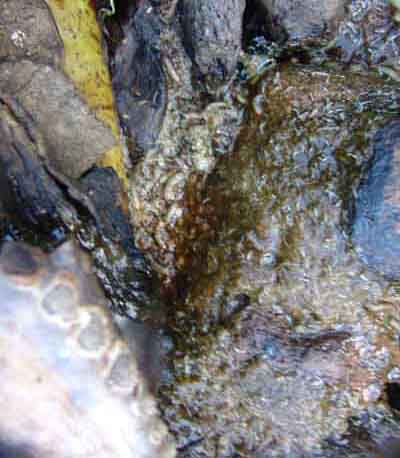
By August 21st, the waters surrounding the base were mostly dried up -- click on the image for a close-up:
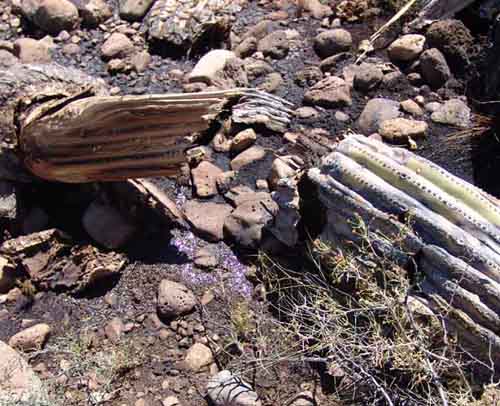
At left, the same two saguaros as photographed above, now seen more than four months later, on January 07, 2005. (Click on the image to enlarge it.)
The second saguaro, at far left, has lost its entire branching superstructure, while the skin of the first continues to slough off the now-dry trunk. The skin of the fallen limb approaching the viewer has slumped into a broken mass looking like weathered cardboard.
Below, on July 08, 2006, almost two years after the lightning strike, the first saguaro has now become an almost elegant skeleton (while its mate to the left has fallen). (Click on the image to enlarge it.)
We are fortunate to have two working scientists with Saguaro Juniper Corporation, Tom Orum and Nancy Ferguson,who regularly perform a Saguaro Census at Saguaro National Park East, and are familiar with the life history of Saguaros. They outline the typical ailment process as follows:
A number of agents and processes produce injuries to the protective tissues of Saguaros -- more gradual agencies include birds, insects, and freezing temperatures, while lightning strikes and wind gusts produce more instantaneous damage.
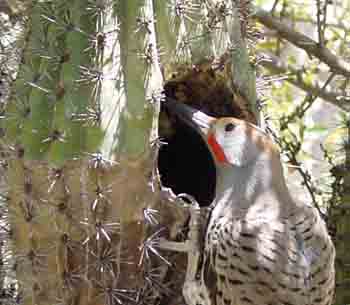
Birds -- mainly woodpeckers (including, prominently, Flickers in our area) -- drill quite large holes in the sides of saguaros in order to construct their nests (for example here, at left). Healthy saguaros respond to this invasive insult by constructing a protective surface at the site of the attack. These interior-protecting surfaces become permanent structures, and are called "boots", since when the plant collapses, the structure.remains as a sturdy, hollow testament to the injury. Below is an example of a very small one, found beside a recently collapsed old tree. (Click on each of the images to enlarge them.) This one, probably drilled by a Flicker, was presumably a "test-hole", abandoned by the bird. But the tree was forced to build the protective structure around the hole nonetheless, as a response to the bacterial infections that naturally follow the injury.
Another kind of injury occurs when a Cactobrosis Moth (Cactobrosis fernaldialis) lays its egg at the base of a Saguaro flower, and its larva burrows its way into the body of the plant. This larva proceeds to eat its way down through the cortical tissues of the tree (feeding on rot its associated bacteria produce), eventually exiting some place in the trunk. It leaves a roughly circular exit hole, evident in the image at far left, and the larva then pupates in the crevices between the flutes of the tree. The Saguaro protects itself even as the larva proceeds, building a small elongated boot-like protective structure, a portion of which was found here beside a recently fallen tree. (Click on each of the images to enlarge them.)
Another example of infection is the presence of a "crown gall", shown below. This growth is a proliferation of plant stem tissues (usually at the base of the plant) that is caused by the bacterium Agrobacterium tumefaciens (which infects the widest host range of any known plant pathogen, causing galls on nearly all plant types except the grasses). This microbe resides in the soil and infects wound sites at the base of the plant. It then transfers some of its DNA into the host plant, causing it to produce growth hormones. (Click on the image to enlarge it.)
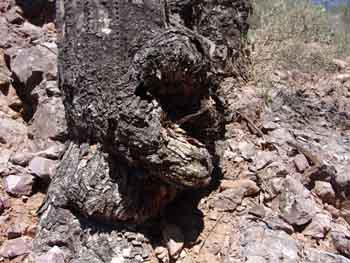
These invasions-and-responses may leave only minor scars, but occasionally more serious bacterial infections set in. The bacterium Erwinia cacticida (a soft-rot pathogen which attacks a variety of cacti), introduced by Cactobrosis Moths and other agencies, multiplies when a plant becomes weakened by any of the causes described above. It produces an enzyme called "pectolitic", which hydrolizes the pectin of the saguaro's cells, causing the cells to collapse and generating the downward flow of liquid observed above. Fruit flies (one species is specialized to exploit saguaros) and other insects are attracted by the aroma, lay their eggs into the rot, and fruit flies in particular also deposit a yeast into the mix, which feeds the larvae that hatch in it (hence the myriad-swarm pictured above).
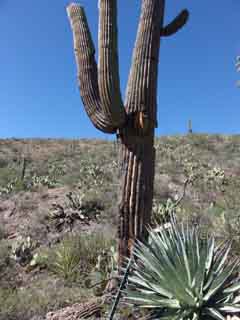 When the tree's defenses are weak and the weather is warm, the collapse happens fast. We saw an example of this in September 2004. On September 9, we hiked down into Sierra Blanca Spring Wash past an old Saguaro we had seen there many times before. This time, however, we saw at first glance that it had lost some of its arms (at left). (Click on each of these three images to enlarge it.) Some of the arms seemed to have been ripped right out of the tree, probably by a strong wind. There was no evidence of lightning. The middle image shows Tom Orum taking some notes -- see the hole on the right in the enlarged image, as well as the broken arm opposed to it. This suggested a very powerful wind indeed. But looking at more closely, on the right, we could see the characteristic rot at the base indicating internal structural collapse rather than external forces.
When the tree's defenses are weak and the weather is warm, the collapse happens fast. We saw an example of this in September 2004. On September 9, we hiked down into Sierra Blanca Spring Wash past an old Saguaro we had seen there many times before. This time, however, we saw at first glance that it had lost some of its arms (at left). (Click on each of these three images to enlarge it.) Some of the arms seemed to have been ripped right out of the tree, probably by a strong wind. There was no evidence of lightning. The middle image shows Tom Orum taking some notes -- see the hole on the right in the enlarged image, as well as the broken arm opposed to it. This suggested a very powerful wind indeed. But looking at more closely, on the right, we could see the characteristic rot at the base indicating internal structural collapse rather than external forces.
This was an old tree, with many signs of previous injuries. First, below left -- (Click on each of these images to enlarge it) -- you can see signs of rot streaking down the left arm of the tree as seen from this viewpoint. Perhaps even more striking, the image at right shows an old Flicker-nest boot, which has become detached from the main growing skin of the saguaro. This may have provided a locus for infections to set in as well, producing a corruption which moves downward through the whole structure.
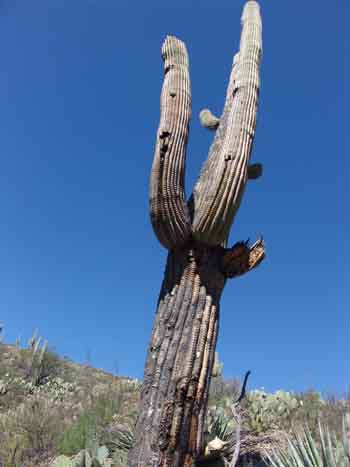 ..
..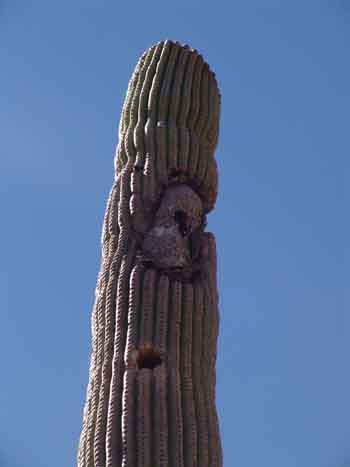
On September 24 (nearly two weeks later), we returned down the same trail, to see the same saguaro, shown at left, has lost both another of ts arms and the top of its central trunk. Click on the image to enlarge it.
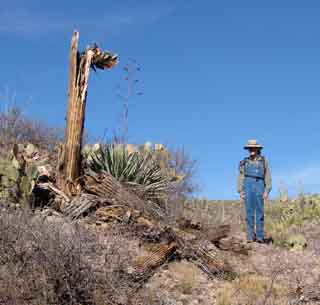 By mid-January of 2005, unsurprisingly, the remaining arm had fallen, leaving a bare stump, blackened at the base (photo right).
By mid-January of 2005, unsurprisingly, the remaining arm had fallen, leaving a bare stump, blackened at the base (photo right).
This suggests that we must look carefully before inferring that lightning has brought down one of these trees just because the body is blackened and the top arms and top of the central trunk have fallen out at right angles to the main body.
Tom Orum's view is that aging is the main cause of the patterns of collapse outlined above. With age (which of course will include repeated bouts of freezing, wind stresses, repeated bird and insect attacks over time), the saguaro bark gradually reduces its capacity for photosynthesis, and the plant's ability to resist the impacts of stressors declines.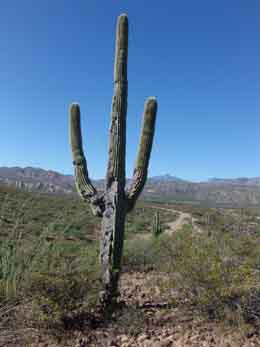
For example, see the image at right. This venerable saguaro has suffered what was probably a severe episode of freezing (perhaps during the Hard Freeze of January 1979), which destroyed cuticle tissue on the north-facing portion of its lower trunk. In response, the plant produced its protective tissue all along a broad vertical stripe Click on the image for a close-up of the tissue repairs.
As you can see, this is a very impressive job of healing, and the plant has grown nicely over the subsequent years. However, it has also lost all of the healed surface in terms of photosynthesis production, which may well lead to slow starvation and hence weakening of resistance to the infections which are always lurking in this massive body.
Ultimately, these massive creatures collapse, and then (following the dissolutions outlined above) they tend to become the homes for a wide variety of smaller animals. For example, see our page on Packrats.
